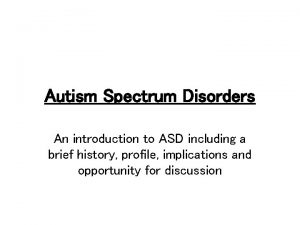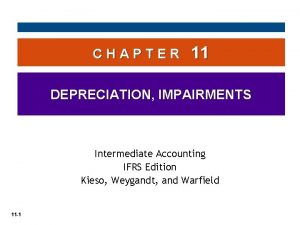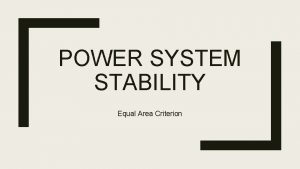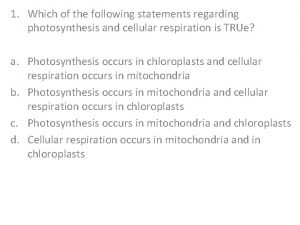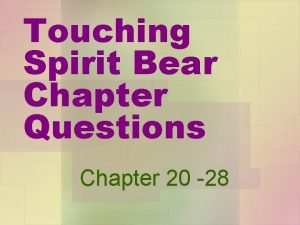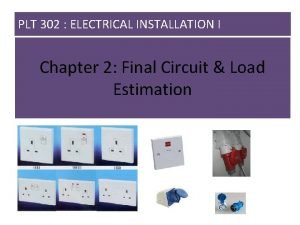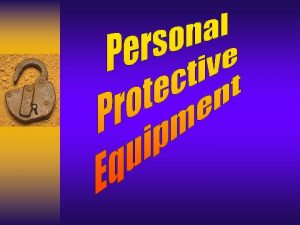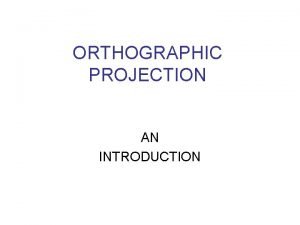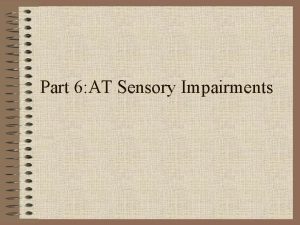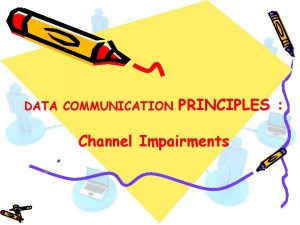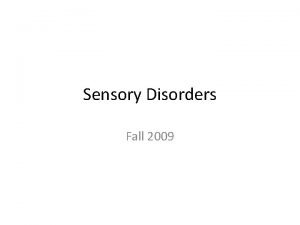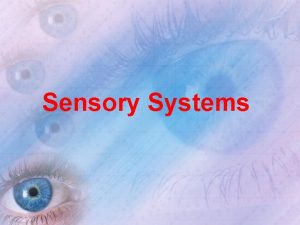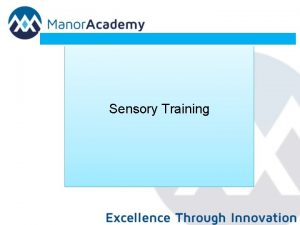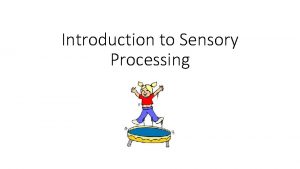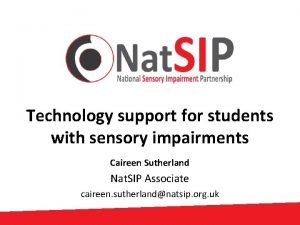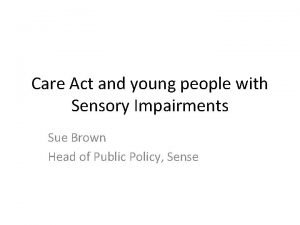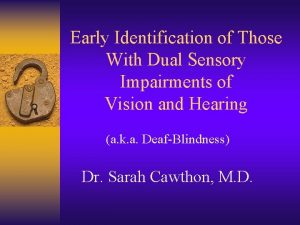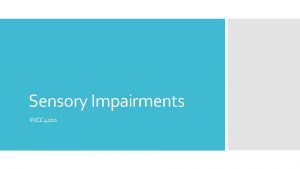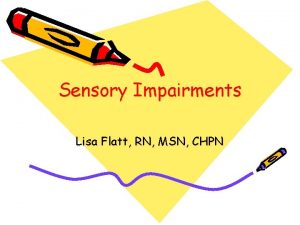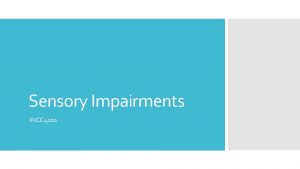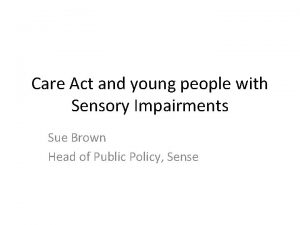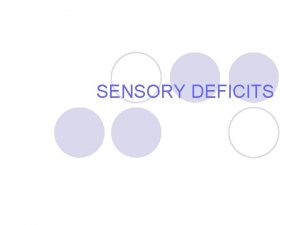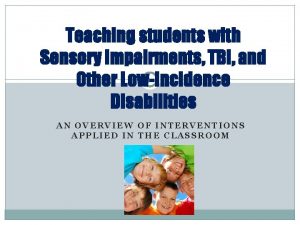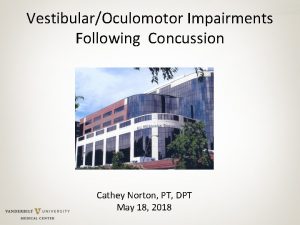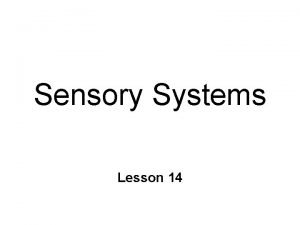Sensory Impairments Following the lecture information regarding sensory






























- Slides: 30

Sensory Impairments Following the lecture information regarding sensory impairments, you should be able to: • Understand the various types of sensory impairments • Describe the educational impact of sensory impairments on students. • Describe how students with sensory impairments are supported in the general education curriculum. • Reflect on the types of interventions and educational strategies used by special education teachers and related service providers. Chapter Objectives

Sensory Impairments • Disorder where brain has difficulty taking in, sorting out, and/or connecting information from the environment. • Over or under sensitivity to touch, joint pressures, movement, sights or sounds, smells or tastes. • Symptoms – Attention and regulatory problems – Sensory defensiveness – Activity levels – Behaviors

Sensory Systems • • Tactile system Vestibular system Proprioceptive system Olfactory system Gustatory system Visual system Auditory system


Tactile System • Nerves under the skin's surface that send information to the brain • Information includes light touch, pain, temperature, and pressure • Important role in perceiving the environment as well as protective reactions for survival.

Tactile System • • • Dysfunction – withdrawing when being touched – refusing to eat certain 'textured' foods and/or to wear certain types of clothing, – complaining about having one's hair or face washed – avoiding getting one's hands dirty (i. e. , glue, sand, mud, finger-paint) – using one's finger tips rather than whole hands to manipulate objects Dysfunctional tactile system may lead to a misperception of touch and/or pain (hyper- or hyposensitive Self-imposed isolation, general irritability, distractibility, and hyperactivity.

Tactile Defensiveness • A condition in which an individual is extremely sensitive to light touch • Tactile system is immature and working improperly • Abnormal neural signals are sent to the cortex in the brain which can interfere with other brain processes. • Brain is overly stimulated and may lead to excessive brain activity, which can neither be turned off nor organized • Over-stimulation in the brain can make it difficult for an individual to organize one's behavior and concentrate and may lead to a negative emotional response to touch sensations.

Tactile Dysfunction • • Hyperactive – may dislike certain foods because of texture – may dislike brushing teeth, using toothpaste – responds with alarm or withdrawal when the face is wiped – has an aversion to haircuts, combing, washing, and showering – avoids walking or crawling on surfaces such as rugs or grass – prefers to wear clothing that totally covers his/her body, regardless of temperature; may prefer no clothing at all – does not like the feel of certain clothing, tags, sheets – dislikes physical touching, especially light touch – may have poor relationships with peers or adults – may become physically or verbally aggressive when touch is perceived as a threat – dislikes crowds, walks at the end of the line at school – may avoid putting hands in sand, finger paint, glue Hypoactive: – does not react to painful experiences – has difficulty manipulating tools and toys – craves touch, may touch constantly or indiscriminately

Vestibular System • Structures within the inner ear (the semicircular canals) – Detect movement and changes in the position of the head – For example, the vestibular system tells you when your head is upright or tilted (even with your eyes closed).

Vestibular System • Dysfunction – Hypersensitive to vestibular stimulation – Movement differences • May appear clumsy • May actively seek very intense sensory experiences such as excessive body whirling, jumping, and/or spinning (hyporeactive vestibular system) – Fearful reactions to ordinary movement activities (e. g. , swings, slides, ramps, inclines). • trouble learning to climb or descend stairs or hills • apprehensive walking or crawling on uneven or unstable surfaces.

Vestibular Dysfunction • • Overactive – gets car sick, dislikes carnival rides – is scared to jump, go up or down stairs, roll in a barrel, climb, lean over backwards to wash hair, do somersaults, rough-house, swing – tries to control and manipulate to avoid distressing sensations, which may make him or her appear obstinate and uncooperative – wants constant physical support from adults Under-active – does not enjoy or do well in sports – is clumsy, stumbles, falls – has trouble doing anything requiring both sides of the body, lacks hand dominance, does not cross midline – confuses right and left – reverses letters and reads words backwards – has delays in speech, reading, and writing as well as in visual perception – can not follow a moving object, draw a line, read a line of print easily or copy from the board – does not become dizzy even after many minutes of spinning, loves fast moving equipment – has trouble holding his or head up while sitting; may tire easily – does not attempt to catch self when falling*does not move trunk normally when turning head or moving arms

Proprioceptive System • • Components of muscles, joints, and tendons that provide a person with a subconscious awareness of body position – An individual's body position is automatically adjusted in different situations – for example, the proprioceptive system is responsible for providing the body with the necessary signals to allow us to sit properly in a chair and to step off a curb smoothly Allows us to manipulate objects using fine motor movements, such as writing with a pencil, using a spoon to drink soup, and buttoning one's shirt

Proprioceptive System • Dysfunction – Clumsiness – tendency to fall – lack of awareness of body position in space – odd body posturing, minimal crawling when young – difficulty manipulating small objects (buttons, snaps) – eating in a sloppy manner – resistance to new motor movement activities.

Proprioceptive Dysfunction • Signs of Proprioceptive Dysfunction: – has stiff and uncoordinated movements – clumsy, bumps into things – craves sensation of deep pressure against the body – must look to see what he or she is doing – has difficulty getting into or out of a chair, going up and down stairs, going up or down a climbing structure – grasp on a pencil is to tense or to weak – breaks pencils from pressing too hard or prints to lightly

Praxis • Praxis or motor planning – The ability to plan and execute different motor tasks. – In order for this system to work properly, it must rely on obtaining accurate information from the sensory systems and then organizing and interpreting this information efficiently and effectively.

Dyspraxia • • Poor motor planning, and is a common manifestation of sensory integrative dysfunction in children with learning disorders. Signs of Dyspraxia – awkward body movements – clumsy, accident prone – difficulty with learning motor games and sports – difficulty with learning new tasks – does not explore surroundings – cannot identify the exact place where he/she has been touched – has messy handwriting – has difficulty imitating body postures – lacks body awareness – breaks toys – seems weak, has low endurance – has trouble dressing, especially with buttons and zippers – has trouble sequencing movements such as jumping jacks – has trouble assembling toys – has difficulty planning and making drawings – has speech and language difficulties – is hyperactive and distractible

Olfactory System • Receptors are located in the olfactory lining of the nasal passages. • Sensory nerve cells, or neurons, with hairlike fibers called cilia on one end. • Neurons send nerve fibers called axons to the olfactory bulb, a brain structure just above the nose. • In the olfactory bulb, information from these receptors is organized into patterns that the brain may interpret as different odors. • Oldest and most vital parts of the brain

Gustatory System • • • Receptors are located in the taste buds (or lingual papillae) on the upper surface of the tongue to provide information about the taste of food being eaten. The human tongue has about 10, 000 taste buds. Five taste sensations – Sweet – Bitter – Salty – Sour Tongue map - misperception Separate populations of taste buds sensing each of the basic tastes are distributed across the tongue.

Visual System • Visual Perception - The ability to analyze and interpret visual input is sometimes referred to as visual processing or visual perceptual skills. Just because a child can see clearly and comfortably does not guarantee that the brain will be able to make use of the incoming information. Visual processing can be broken down into several areas including: – Laterality and directionality – Visual form perception, memory, motor integration – Figure ground – Spatial relations

Visual System • Signs of Visual Perception Disorder – bumps into things – lacks personal boundaries – has disorganized possessions and space(runs out of space on paper when printing name, has difficulty lining up numbers) – has difficulty holding eye contact – has difficulty with depth perception – has poor attention to visual details – has poor handwriting – may avoid reading, writing, and drawing – has difficulty with building and doing puzzles – gets lost easily – has difficulty recognizing and drawing letters, numbers, shapes – is unable to move through objects guided by vision – has poor balance

Auditory System • Auditory processing is a term used to describe what happens when your brain recognizes and interprets the sounds around you. Humans hear when energy that we recognize as sound travels through the ear and is changed into electrical information that can be interpreted by the brain. The "disorder" part of auditory processing disorder means that something is adversely affecting the processing or interpretation of the information.

Auditory System • Signs of auditory processing disorder – Have trouble paying attention to and remembering information presented orally – Have problems carrying out multistep directions – Have poor listening skills – Need more time to process information – Have low academic performance – Have behavior problems – Have language difficulty (e. g. , they confuse syllable sequences and have problems developing vocabulary and understanding language) – Have difficulty with reading, comprehension, spelling, and

Educational Impact • • • Overly sensitive to touch, movement, sights Inability to habituate to sounds and fear with unexpected noises Easily distracted Holding hands over ears in complex environment Avoids tastes, smells, or textures normally tolerated by children that age Activity level that is unusually high or unusually low Impulsive, lacking in self-control Inability to unwind or calm self Poor self-concept

Educational Impact • • • Social and/or emotional problems Physical clumsiness or apparent carelessness Hesitation going up or down stairs Difficulty making transitions from one situation to another Holding on to walls, furniture, people, or objects, even in familiar settings • Delays in speech, language, or motor skills • Delays in academic achievement

Educational Considerations • • • Create an environment that is full of a variety of sensory input. – Sensory diet – Inputs may include colors, light and dark, sounds, music, things to climb on, different textures, and opportunities for movement and exploration – Exposing all of the senses to various types of input Adapt the activity, or even avoid it when necessary if student does not like light touch – Use a firm, calming, deep pressure touch – Find a quiet place to complete assignments and prepare for tests. Processing sensory input simultaneously – For example, student may not be able to talk while walking on a balance beam. – She may not be able to look at you when you are giving her verbal instructions. – Difficulty looking at speaker when receiving instructions or discipline.

Educational Considerations • • • Sensory Integration (SI) Therapy – focuses on the tactile, vestibular, and proprioceptive systems – does not teach specific skills; rather, it provides exposure to sensory input in a controlled environment. . Deep pressure – Weighted vest, blanket, or wrist or ankle weights – Swinging in a blanket – Being rolled in a blanket like a "hot dog, " – Pulling each other across the room in a laundry basket – Carrying heavy milk cartons are all excellent activities. – The Wilbarger Brushing Method, developed by Patricia and Julia Wilbarger, uses a surgical scrub brush to stimulate the touch receptors, followed by deep pressure (proprioception) on the joints. Control the environment by making decisions about the sights, smells, and sounds

Sensory Disorders • • Sensory Integration - ”The ability to synthesize, organize, and process incoming sensory information received from the body and the environment to produce purposeful goal-directed responses. ” - Dr. Jean Ayres Sensory integration disorder - a term used to describe a person who has difficulty with the processing of sensory input. There are several types of sensory integration dysfunction. Dysfunction can occur with a specific sensory system or with many systems(global). – Vestibular dysfunction--means the brain isn't correctly processing information coming from the vestibular receptors located inside the ears – tactile dysfunction---tactile stimulation coming from the skin isn't being processed correctly. – global dysfunction---a combination of sensory systems that are not integrating correctly.

Sensory Disorders • Input from three basic senses (touch, movement, position) combined with the auditory and visual senses are critical to the development of mature motor planning, coordinated use of both sides of the body, balance, eye-hand coordination, body awareness, language, visual perception, and emotional stability. • A child with sensory integration dysfunction experiences frustrations and inadequacies, and often exhibits behavior problems, poor social relationships, and low self-esteem. Addressing those dysfunctions in therapy can reduce frustrations and build skills so that the child feels capable, successful, worthy, and important.

Symptoms of Sensory Integration Dysfunction • Teachers or parents often observe the following symptoms/behaviors that may lead to a referral for an evaluation of the sensory systems. This evaluation usually is done by an occupational therapist. – Posture Control • slouches • props head when sitting • uses support when standing – Fine Motor • difficulty manipulating objects such as scissors, blocks, beads • awkward grasp on objects such as pencils(too tight or too weak) • difficulty tying shoes, buttoning shirt – Gross Motor • skipping, hopping, running are awkward or impossible to do • stumbles • bumps into things

Symptoms of Sensory Integration Dysfunction – – Perceptual Skills • difficulty matching objects • loses place when copying or reading • difficulty putting together puzzles • misjudges distances when reaching for objects or setting things down Cognitive Skills • Distractible • unable to transfer/generalize skills • usually an average IQ Psychosocial Skills • poor self-esteem • throws tantrums • gets frustrated easily Sensory Processing • hypersensitive to sensory stimuli(e. g. . , loud noises) • touches everything/nothing • hates being hugged/loves physical contact • afraid of movement/loves movement • lethargic/unusually active
 Wings triad
Wings triad Depreciation vs impairment
Depreciation vs impairment Intermediate accounting chapter 11
Intermediate accounting chapter 11 Give practical examples of the modifiers of human acts.
Give practical examples of the modifiers of human acts. Chapter 11 intermediate accounting
Chapter 11 intermediate accounting Inquiry letter for college admission
Inquiry letter for college admission Applications of equal area criterion
Applications of equal area criterion Which of the following statements regarding
Which of the following statements regarding Consider the following statements regarding photosynthesis
Consider the following statements regarding photosynthesis 01:640:244 lecture notes - lecture 15: plat, idah, farad
01:640:244 lecture notes - lecture 15: plat, idah, farad Unified health management information system
Unified health management information system As cole carves the totem, what two questions haunt him?
As cole carves the totem, what two questions haunt him? Hearsay legal
Hearsay legal Iee regulations regarding 13a socket outlets
Iee regulations regarding 13a socket outlets 29 cfr 1910 ppe
29 cfr 1910 ppe Which is the false statement regarding rdas?
Which is the false statement regarding rdas? Which statement is true regarding squall lines?
Which statement is true regarding squall lines? Third angle projection explained
Third angle projection explained Characteristics of contingent contract
Characteristics of contingent contract Internal check regards wages
Internal check regards wages Answer the questions below regarding the heating of a house
Answer the questions below regarding the heating of a house Chapter 14 section 1 the search for spices
Chapter 14 section 1 the search for spices Hình ảnh bộ gõ cơ thể búng tay
Hình ảnh bộ gõ cơ thể búng tay Ng-html
Ng-html Bổ thể
Bổ thể Tỉ lệ cơ thể trẻ em
Tỉ lệ cơ thể trẻ em Chó sói
Chó sói Glasgow thang điểm
Glasgow thang điểm Chúa yêu trần thế
Chúa yêu trần thế Các môn thể thao bắt đầu bằng tiếng chạy
Các môn thể thao bắt đầu bằng tiếng chạy Thế nào là hệ số cao nhất
Thế nào là hệ số cao nhất
